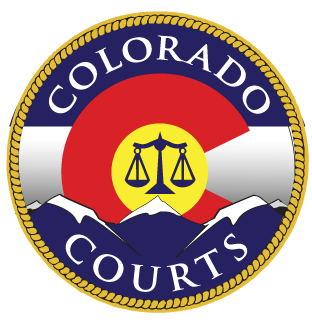How to start the case?
General Information
You may file your Complaint in the County where the transaction occurred or the in County where the Defendant lives. The amount you are claiming cannot exceed $25,000.00.
If you are the Defendant do not disregard the Complaint. A judgment could be entered against you, and the other party could start collection procedures. If you are the Plaintiff do not disregard an answer or counterclaim. A judgment could be entered against you, and the other party could start collection procedures.
The Court cannot collect your judgment for you.
Representation by an attorney may be required for Corporations, Limited Partnerships, Closely Held Entities, etc. Please see C.R.S. § 13-1-127, C.R.S.
For additional information, please review the relevant Colorado Rules of Civil Procedure Chapter 25.
Complete instructions can be found in JDF 110 - Instructions for a County Court Civil Case (Money Demand).
How to File
- Fill out forms.
- Detailed Instructions: JDF 110.
- CRCCP Form 2 - County Civil Complaint;
- CRCCP Form 1 - Summons (caption box only); and
- CRCCP Form 3 - Answer (caption box only).
- Note - The Court will give you a Case Number when you file.
- File.
- Go to the clerk's office in the courthouse.
- Bring two copies of the form from Step 1.
- Pay or waive filing fee. Expand below for more information on filing fees.
Cases for $25,000 or Less Filing Fees
Cases for $25,000 or Less Filing Fees
| Description | Fees |
|---|---|
| To Start (Cases for $1.00 - $999.99) | $95.00 |
| To Start (Cases for $1000 - $14,999.99) | $115.00 |
| To Start (Cases for $15,000 - $25,000) | $145.00 |
| To Respond (Cases for $1.00 - $999.99) | $90.00 |
| To Respond (Cases for $1000 - $14,999.99) | $110.00 |
| To Respond (Cases for $15,000 - $25,000) | $140.00 |
| Request A Jury Trial | $98.00 |
Unable to afford a filing fee? Visit filing without payment
- Return Date.
- Come back to court on this date.
- Let the court know if an agreement has been reached or
- if the Defendant failed to respond.
- The Court will schedule a hearing (14 to 63 days out from filing date).
- Serving the Defendants
- See full Instructions for Service of Process.
- The process server will return a completed JDF 98 - Affidavit of Service to you.
- File that form with the court.
Each Defendant must be served a copy of the court forms.
How to respond to the lawsuit?
Respond to the summons
File:
- Use form CRCCP Form 3 - Answer to respond or counterclaims
- State your defenses in writing.
Why?
• This is your chance to respond to the accusations in the complaint.
When?
• File on or before your court appearance.
• The appearance date is listed on the Summons you were served.
Fee:
• Pay or waive the filing fee.
How do I reverse a default judgement?
File a Motion to Set Aside a Default Judgment
A Defendant can file JDF 78 Motion to Set Aside Default Judgment asking the Court for one more chance to provide information on the case before the Plaintiff can start a money or property collection process. The Defendant must also file CRCCP 3 Answer Under Simplified Procedure (including any Counterclaims and or Crossclaims) with the Court at the same time along with paying the filing fee. After the Court reviews the JDF 78 Motion and the CRCCP 3 Answer, an additional hearing may be scheduled by the Court to determine the outcome of the case.
Day of Court and Possible Outcomes
Day in Court
Make sure that you appear on your court date. If you fail to appear, your case may be dismissed.
It is important that you are on time or early for your court hearing and that you have all of your information with you.
Please turn off your cell phone and respect all parties in the courtroom.
You may be asked to speak to the other party before the court hearing to determine if the claim can be settled to avoid going to trial.Possible outcomes
If both the Plaintiff and Defendant appear, then one of the following situations may occur:
1. The Plaintiff and the Defendant can agree to talk and work out certain acceptable conditions that could include, for example, the payment of the claim, a payment plan, etc. The agreements, called a Stipulation, need to be put into writing on a JDF 75 Stipulation form, which you can get from the clerk's office. The JDF 75 Stipulation form must be signed in the presence of a court clerk or notary public.
If a Stipulation is reached, a JDF 106 Stipulation Order must be filed along with the JDF 75 Stipulation form. Complete the caption box only on the JDF 106 Stipulation Order. The Court will complete the remaining sections and give you a signed copy.
2. The Defendant can file an Answer disagreeing with the claim of the Plaintiff any time after being served with the Complaint, up to and including the first court date. The purpose of the Answer is for the Defendant to respond to the accusations in the Complaint and to state any claims against the Plaintiff that the Defendant might have. The Defendant may file an Answer on the court date as an opportunity to discuss the issues with the Plaintiff or his/her attorney in the courtroom before the case proceeds.
3. The Plaintiff can ask for an extension of the court date by filing a JDF 76 General Motion if the Plaintiff feels that further discussion with the Defendant is necessary or if the Defendant is given another opportunity to fulfill a pre-arranged agreement. This can create an opportunity for everyone to agree without a trial.
4. A court or jury trial can be requested and set for a future date.
If the Plaintiff appears and the Defendant does not appear, and an Answer or Counterclaim was not filed by the Defendant, and the Plaintiff has followed the procedure correctly, the next steps for the Plaintiff are:
1. Complete JDF 107 A - Motion for Entry of Judgment.
2. Complete the caption box only on Form 7 - Order for Entry of Judgment with Issuance of Interrogatories. The Court will complete the remaining sections on the form and give you a signed copy.
3. The Court may award a money judgment to the Plaintiff(s).
If the Defendant appears and the Plaintiff does not appear, one of the following situations may occur:
1. If a Counterclaim has been filed and personally served to the Plaintiff, the Court may award judgment to the Defendant.
2. If no Counterclaim has been filed, the Court may dismiss the case.
How do I collect if I win?
General Info and Forms
Basic Info
• The Court doesn't collect for you.
• The Court must have awarded a money judgment in your favor.
• The money judgment is good for six years in County Court.
• Read Rule 369 and Rule 403.
See the self-help forms section for a complete listing of potential Forms.
How do I file a contempt citation?
General information
You must file your documents in the case in which the Court awarded a money judgment in your favor.
- A money judgment from County Court is good for six years from the judgment date.
- A money judgment from District Court is good for 20 years from the judgment date.
You may file if the Judgment Debtor has not complied with the Court Order, e.g. failed to respond to interrogatories following service or has filed an answer that does not adequately respond to the questions. The Court cannot collect your money judgment for you.
For additional information, please review the Colorado Rules of County Court Civil Procedure – Rule 369 and 407 or Colorado Rules of Civil Procedure – Rule 69 and 107.
Instructions and forms to file for a Contempt Citation.
 Colorado Judicial Branch
Colorado Judicial Branch
